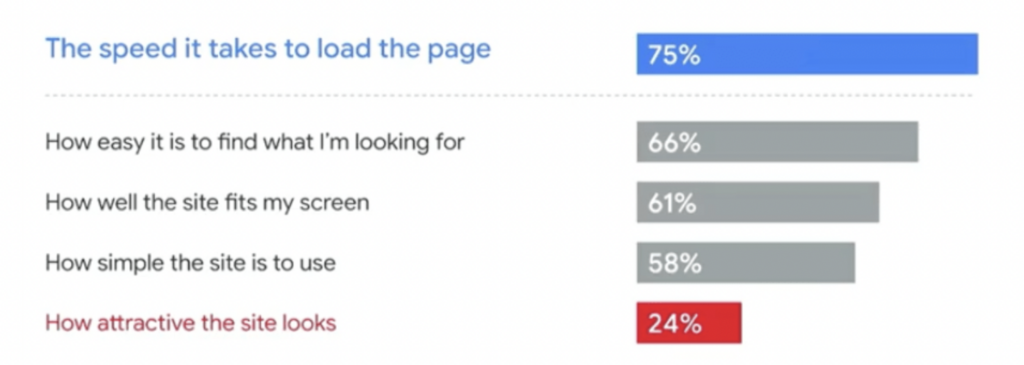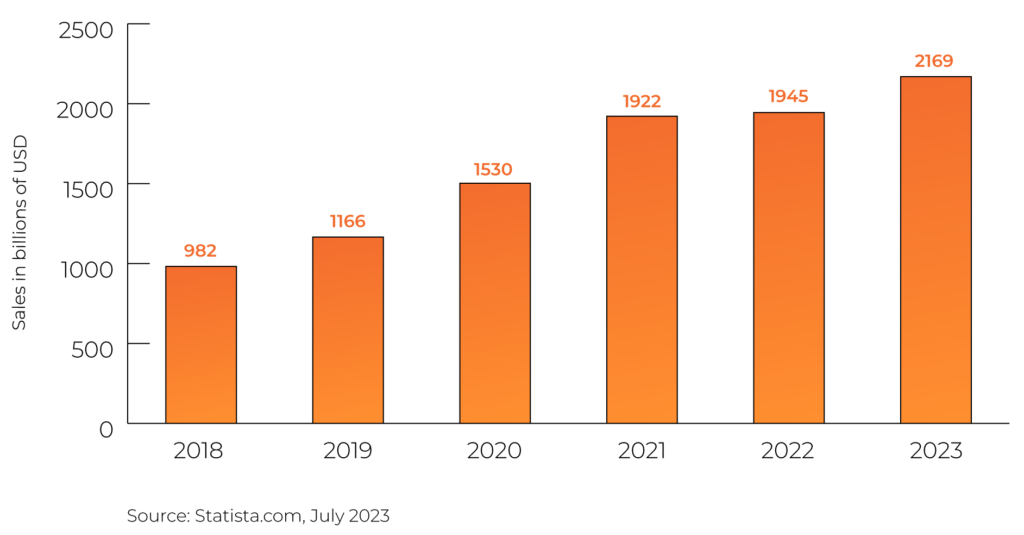How to choose the right e-commerce platform
Choosing the right e-commerce platform for an enterprise business is critical for the success of the business and its smooth functioning and growth. The customer experience is constantly evolving and shopping habits and behaviors can change literally overnight (just like in a pandemic). Your platform needs to be ready to meet all customer demands and deliver a consistent user experience across the omnichannel.

It is not an easy decision to choose the right platform as there are over 350 e-commerce platforms available on the market, not to mention that you can always choose to create your own custom solution. It is difficult to navigate, as most of them offer similar functionalities. Worse still is the knowledge that choosing the wrong solution can have immeasurable consequences – a waste of time, money and energy for all parties involved.
At the beginning, you need to think about these aspects:
- The ability to handle growth in the future – is the platform able to quickly respond and expand the offers and services
- What are the costs of running the platform – implementation is just the first step, how much will the ongoing and maintenance cost
- Customer experience – what tools does the platform offer to impress the customers, is it good enough to keep up with the growing number of digital touchpoints
- Customer service – what level of customer service does it provide (to support conversion, loyalty, and retention)
Key questions you should ask yourself before choosing a platform:
- What are your business goals and needs?
- What are your technology requirements and expectations?
- What budget do you have available for your e-commerce project?
- What are your scalability and flexibility requirements?
- What are your requirements for integration with existing systems and services?
- What are your legal requirements and requirements for data security and protection?
Custom solution vs. ready-to-use platform
As an enterprise business, you have only two options to choose from: custom solution or already built. The custom solution option may look very tempting at first glance. Still, it leads to several problems. It can be very expensive and time consuming and you won’t be able to use the funds to grow your business.
Disadvantages of custom solutions:
– higher development costs
– solving already solved problems and developing new components
– allocating developers’ capacity to maintain the core system instead of supporting the company
For these reasons, you should consider choosing an existing solution that is sufficiently scalable, and the maintenance and security of the system are done at a time when you can develop your own business. Already-built e-comm platforms can save your time and money on the development. Moreover, they are usually intuitive, easy to navigate, performant and mobile-optimized.
So how to choose a platform?
Choosing the right solution for your business depends on your digital commerce objectives. You need to be clear about your business requirements and the needs and desires of your customers. It is crucial not to underestimate this phase and to prepare a survey on this topic, hold meetings with all stakeholders in the company and subject your products and services to the uncompromising gaze of customers. Only then you will be sure you have a customer-centric lens.
As a guide to evaluate your business criteria you can try the MoSCoW method. It divides them into 4 groups, must-haves, should haves, could haves and won’t haves.
Must Have
• Non-negotiable
• Minimum viable product
• Unable to deliver end product without this
• Not legal with it
• Unsafe without it
• Without this project
is not viable
Should Have
• Important but not vital
• Maybe painful to leave out but the solution is still viable
• May need some kind
of workaround
Could have
• Desirable but not as important as Should Have
• Only do if there is
extra time and budget
Won’t Have
• Won’t have this time
around at all
• Out of budget
• Nice to have but has
no real impact
So what are the key factors that you should consider before choosing the platform? Here are some important factors and limitations to consider in the selection process:
- Hosting and ownership of the platform
- Costs (Total cost of ownership)
- Customization, integrations and plugins
- User Experience (UX)
- Performance
- Scalability
- Multichannel capabilities
- Security
- Mobile experience / responsive design
- SEO
- Technical support
- Other
1. Hosting and Ownership of the Platform
Self-hosted vs. cloud
Self-hosted: you need to find hosting, sort out the installation and take care of the updates
+ better control over the platform, better security, better view of data
– more work to be done, higher costs
Cloud: you need to find a cloud platform
+ lower maintenance costs, better customer support
– less control over the servers (less flexibility)
Ownership – open source vs. SaaS
Open source: web hosting, security, integrations and analytics are your responsibility
+ better control, code can be modified
– expensive to maintain, need of technical know-how
SaaS (software as a service): you are renting the platform, SW management tasks are done by the provider
+ cheaper, less work, faster time-to-market
– limited flexibility and customization
2. Costs (Total Cost of Ownership)
Pricing is usually one of the key factors to be considered when choosing the right platform. It tends to be the most important thing for many companies. Look for a platform that offers a good balance between features, scalability, and cost.
What will be the estimated costs of the platform per year? The price depends on many aspects including design, configuration, maintenance etc. Therefore, it is crucial to assess the total cost of the platform, not just the implementation, but also the transaction, turnover and other fees, hosting, etc. You should also consider the lengths of the contract and platform’s estimated useful life.
Another thing needed to be taken into account is the convenience of your customers – the possibility to pay via third-party vendors (e.g. PayPal). Avoid platforms that charge exorbitant fees or lock you into long-term contracts.
Costs you should think about:
- hosting
- license fee
- maintenance
- implementation / development
- costs of add–ons, plugins etc.
- commission-based costs
3. Customization, Integrations and Plugins
Enterprise businesses have unique needs and requirements that may not be met by an off-the-shelf e-commerce platform. Look for a platform that is customizable and allows for integrations with third-party tools and applications.
Make sure to check whether the chosen platform has all the necessary features and functions, and offers all the integrations you need. Remember to check that platform also provides API access so that it can easily integrate with other systems that your company runs on. The most popular plugins include: emailing tools, accounting, tax calculators, payment gateways and shipping apps, accounting, loyalty programs, digital tools for integration with tools such as CRM, ERP, marketing automation.
The most popular plugins include:
- emailing tools
- accounting, tax calculators
- payment gateways and shipping apps
- loyalty programs
- digital tools for integration with tools such as CRM or ERP
- marketing automation
Another important aspect is whether the platform has a functional community that is constantly trying to improve it and solve problems that arise.
What you should consider:
- How customizable is the platform?
- Can it be tailored to meet the specific needs of the business?
- What kind of integrations does the platform support?
- Does it integrate with third-party applications and tools?
- How big is the ecosystem around the platform? How many agencies, developers, local plugins?
- What is the platform roadmap and vision? Does it align with your business?
4. User Experience (UX)
In order to keep up with the competition, you must provide an excellent and intuitive UX. It becomes more and more important, as customers care about not only the product and price, but also about the shopping environment. The quality of UX is becoming a crucial differentiator. You should create an elegant, welcoming and simple to use interface with a variety of options.
Most of the platforms offer a great variety of themes to choose from. Some are free, some are for additional fees. If you want to impress your customers, spare no expense on this item. Only a well-done design will differentiate you from the competition and turn the users into customers.
Choose an e-commerce platform that offers excellent customer support, including a knowledge base, tutorials, and online support. Enterprise businesses may also need access to a dedicated account manager for more personalized support.
What you should consider:
- What options does the platform offer in terms of UX and UI?
- What kind of customer support does the platform offer?
- Is there a dedicated account manager available for personalized support?
5. Performance
Speed is one of the key user aspects. In fact, it is the most important one. How fast your site loads will affect not only the overall user shopping experience, but also your sales.
What matters most to users?

Your e-commerce platform must provide satisfying speed even as you scale and grow. You can start evaluating the performance from the bad indicators – poor loading times, frozen pages, 404 and so on. And not only during regular traffic, but also in shopping peaks.
What you should consider:
- Does it provide satisfying performance?
- How does it perform during peaks such as Christmas season or Black Friday?
- Does it have a wide network of servers close to your customers?
- Is it optimized for mobile devices?
- What level of support for SEO performance is in place (url rewrites, meta tags, robot instructions)?
6. Škálovatelnost
Another important factor is how the platform handles scalability and updates. Enterprise businesses need an e-commerce platform that can grow with their business. The platform should be able to handle large volumes of traffic and orders, as well as support multiple websites and storefronts.
What you should consider:
- How scalable is the platform?
- Can it handle large volumes of traffic and orders?
- What are the fees for extra features and storage?
- In which countries is the platform supported?
- How does it handle legal requirements such as regulations and taxes?
7. Multichannel capabilities
Using different channels for selling your product or services is crucial for increasing your revenue. A good e-commerce platform for an enterprise business should allow for multichannel selling, including social media (Facebook, Instagram), marketplaces, and mobile devices. This is important for reaching a wider audience and increasing sales.
What you should consider:
- What multichannel capabilities does the platform offer?
- Can it support social media, mobile devices, and marketplaces?
- Does it have an API to connect with external systems?
Other “multi” aspects supporting growth and reaching new markets are multi-store, Multi-language and multi-currency support. For international operations, it’s crucial to support multiple languages and currencies, which can be technically and logistically challenging.
8. Security
In the digital age, secure websites are crucial to maintain your credibility. You handle a lot of sensitive data and you must protect customers’ privacy. They will not buy from you unless they feel that their data are secured. The most common types of e-comm digital frauds are identity theft, phishing and account theft.
Therefore, security is a critical factor to consider when choosing an e-commerce platform. Look for a platform that has robust security features, such as PCI compliance (Payment Card Industry), SSL certification (Secure Sockets Layer), fraud prevention, and encryption of customer data and their backup.
What you should consider:
- What security features does the platform offer?
- Does it comply with PCI DSS standards, and is customer data encrypted?
- What are the security credentials of the platform?
- What is the level of security certification?
- Apart from built-in security, what extra security options does the platform offer?
- Does it offer SSL and secure backup of data?
- Does it perform security audits?
- Does it offer two-factor authentication for sensitive information protection?
- Is there support of ACL (Access Control List) for both customers and your employees?
9. Mobile experience / responsive design
As mobile transactions continue to increase, your platform needs to be mobile-ready and mobile-friendly. The design and structure must support an intuitive and seamless customer journey within the mobile experience.
Maintaining separate mobile and desktop sites can be costly and time and resource intensive. A better solution is responsive design, which automatically adapts the display to the device the customer is using. You also benefit from the enhanced user experience that this solution provides.
What you should consider:
- Does the platform support responsive design?
- How many responsive themes and templates does it offer?
- Is it possible to edit HTML and CSS directly?
- How easy is it to change elements of the pages?
- Can you create your own Template without design limitations?
- Does it allow you to use a technological stack that you and your team knows?
Global m-commerce sales

10. SEO (Search Engine Optimization)
To be successful in your business, your platform needs to take SEO into account and create a structure that supports it to the fullest extent possible, taking into consideration Google’s ever-changing algorithms. You need to find out what SEO features your platform offers – for example, whether it provides metadata product updating, image captioning, adding custom domain name or blog, search result pagination, customer reviews, map support, etc. All these features may have a great impact on your SEO ranking.
What you should consider:
- Is it possible to convert URLs into SEO-friendly ones?
- Does it support Google Analytics?
- Does it provide access to the robot.txt file or the XML sitemap?
- Is there a way to create URL rewrites when the URL for product changes?
- Does it natively support meta tags?
- Does the website work without JavaScript (at least for the needs of SEO engines).
11. Technical support
Many situations, such as server outages or crashes, can prevent customers from accessing the site and making purchases. In addition to loss of revenue, this can also affect your brand. You need good technical support to get you out of these unpleasant situations as fast as possible.
What you should consider:
- What kind of support does the platform provide?
- What is the availability of the tech support (24/7 or limited)?
- What means of support does it offer (via phone, online, chat etc.)?
- What are the costs of support?
- What does onboarding look like?
- Does it have a knowledge base?
- What is the uptime (outages) history of the platform?
12. Other
Payment Options
It is necessary to offer your customers numerous options on how to pay for your goods and services. Therefore, it is vital that your store is connected to a secure payment gateway. Not all the platforms provide every gateway. Geography is key to payment localization. Make sure that your chosen solution has a wide enough range of payment options.
Personalization
Personalization is a key factor in customer acquisition and retention. Artificial intelligence (AI) and machine learning can help you with recommendations based on previous purchases, customer behavior, demographics or psychographics. Only then you can provide a truly personalized experience and take your sites to the next level.
Analytics and reporting
An e-commerce platform that provides comprehensive analytics and reporting is essential for understanding customer behavior, tracking sales, and making informed business decisions.
- What kind of analytics and reporting does the platform offer?
- Can it provide detailed insights into customer behavior and sales?
- Can you connect the platform to 3r party analytics and reporting tools?
Store functionality and usability
The Product Management System is the key element of your business. You should consider following features and functions:
- bulk upload of products and high-res images
- dynamic filters
- custom data attributes for products, categories etc
- workflow support – to validate products and articles before you publish it by superior employee
- categorization
- shipping possibilities
- advanced features (wish list, recently viewed…)
Creating categories and mapping the products to them should be easy and smooth as well as creating product variations and combinations.
Order Management System
Communication with your customers about their orders is supposed to be regular and accurate. They expect a smooth and quick process. You will need a reliable system which can handle order tracking, sending notifications, communication with inventory systems, etc.
Useful tips:
Our advice is to seek a cloud-hosted, scalable solution with out-of-the-box features and functionalities that satisfy your growing business’s needs from day one. Things like advanced caching methods and the ability to automatically purge content when updating product descriptions are also worth considering. Also, ensure good customer/technical support to your users.
Examples of platforms
Adobe Commerce is a flexible and scalable open-source e-commerce platform with a rich ecosystem of extensions and integrations. It is suitable for medium and large businesses that need individual customization and control over their e-commerce store.
Pros:
- Great flexibility and customization options
- Extensive integration options with third parties
- Support for B2B and B2C sales
- Active community and many resources available

Shopify Plus is the premium version of the popular SaaS e-commerce platform Shopify. It is aimed at medium and large businesses that need fast deployment, easy management, and scalability.
Pros:
- Easy online store setup and management.
- Intuitive user interface
- Extensive ecosystem of apps and integrations
- Sophisticated extensibility and customisation mechanisms
- 24/7 customer support
Shoptet Premium is a Czech SaaS e-commerce platform that offers various plans for small and medium businesses. Shoptet Premium provides advanced features for businesses that need more control over their e-commerce store.
Pros:
- Czech localization and support
- Flexible customization options
- Built-in marketing tools
- Easy integration with Czech payment and logistics services
PrestaShop is an open-source e-commerce platform that is popular for small and medium-sized businesses. PrestaShop offers a wide range of modules and templates that make it easy to create and manage an online store.
Pros:
- Open-source and free
- Large community and many resources available
- Easy customization and extensibility
- Availability of localizations, including English
WooCommerce is a popular e-commerce plugin for WordPress that is suitable for small and medium-sized businesses. It integrates easily with your existing WordPress site and provides flexible customization options.
Pros:
- Easy integration with WordPress
- Great flexibility and customization options
- Extensive third-party integration options
- Large user community and many resources available
Fully custom made platform
Choosing a custom-made e-commerce platform can be a strategic decision that offers numerous advantages for businesses looking to establish a strong online presence.Yet it leads to several problems. It can be very costly and time-consuming, and you won’t be able to use the funds to grow your business.
Pros:
- You are not constrained by the limitations of pre-built platforms
- Unparalleled flexibility in design and functionality
- Optimized performance – off-the-shelf solutions often come with unnecessary features and code, which can impact website performance
How to proceed and which platform to choose?
Let us help you! We will analyse your needs and recommend the optimal solution. Just contact us using the form below or book your consultation here and we will get back to you.




